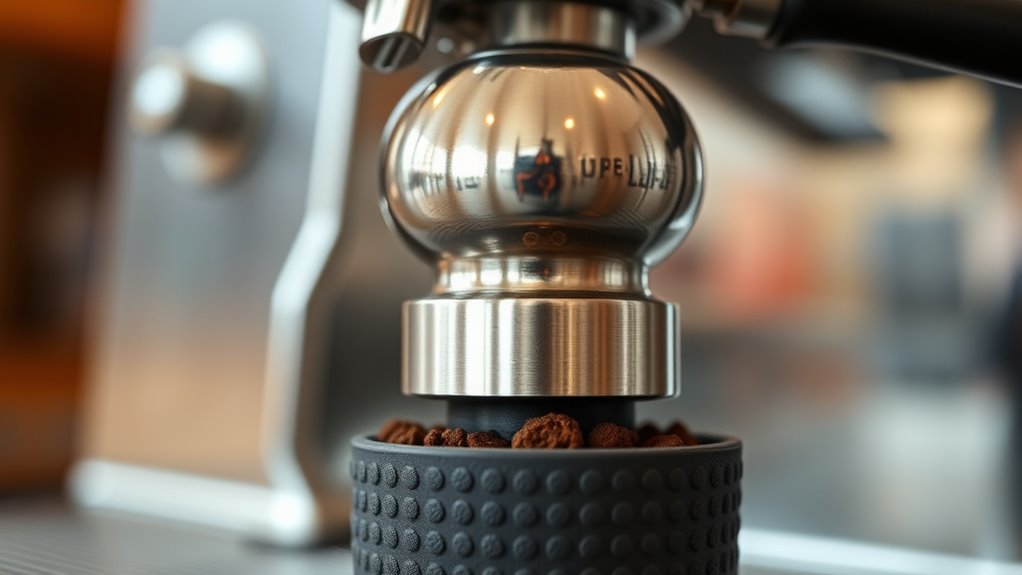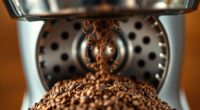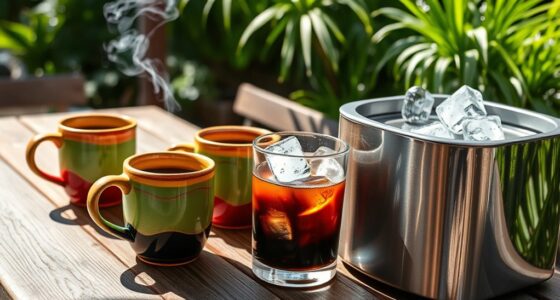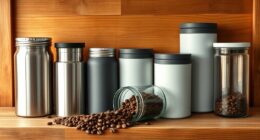A coffee tamper is essential for making great espresso because it evenly compresses the ground coffee in the portafilter. This guarantees uniform water flow and helps achieve balanced extraction, leading to better flavor. Proper tamping technique, including applying the right pressure and distributing grounds evenly, is key. Using the right size and maintaining your tamper keeps your shots consistent. Want to learn more about how to perfect your tamping skills? Keep exploring to improve your espresso game.
Key Takeaways
- Coffee tampers compress ground coffee evenly in the portafilter, ensuring optimal water flow and consistent espresso extraction.
- Proper tamper size and material are essential for a secure fit and durability, typically matching 58mm baskets.
- Applying consistent, level pressure (15-30 pounds) with proper technique prevents channeling and improves flavor.
- Regular cleaning and maintenance of tampers preserve performance and prevent oil buildup that can affect taste.
- Additional tools like distribution tools and puck screens can enhance tamping consistency and espresso quality.

A coffee tamper is an indispensable tool that compresses ground coffee into the portafilter basket, guaranteeing even water flow and balanced extraction. When you press the grounds firmly, you create resistance against the pressurized water passing through, which helps prevent channelling—those unwanted pathways that cause uneven saturation. This results in a uniform coffee puck, with consistent density throughout, which is essential for a well-balanced espresso shot. Using the right tamping technique also ensures optimal contact between the grounds and water, maximizing flavor extraction. Without proper tamping, the water can bypass loose grounds, leading to weak, under-extracted espresso that lacks flavor and crema. By transforming loose grounds into a cohesive “cake,” the tamper plays an important role in controlling extraction quality, alongside grind size and dose.
Design choices for tampers vary to suit different needs. Some feature flat bases, while others have convex surfaces, affecting how pressure is distributed across the puck. Manual tampers require you to apply force, typically between 15 and 30 pounds, with consistency more important than maximum strength. Ergonomic, spring-loaded models help you maintain a steady pressure effortlessly.
Materials range from stainless steel and aluminum to coated finishes, offering durability and resistance to corrosion. Tamper size must match your portafilter, often 58mm for commercial machines, guaranteeing a proper fit. Weighted designs, usually between 400 and 600 grams, help you apply consistent pressure without strain, promoting uniform tamping every time.
When you tamp, use a level, even pressure to prevent uneven pucks that cause uneven extraction. A twisting motion during tamping helps seal the edges of the puck, improving water contact and extraction consistency. Many baristas emphasize that technique and consistency are more important than applying maximum force; a calibrated tamper can help you reproduce the same pressure repeatedly.
Common mistakes include uneven pressure, which creates lopsided pucks, or insufficient compression, leading to fast, weak shots. Tamping on an angled surface or re-tamping after distribution can disturb the grounds, resulting in poor extraction. Matching your tamper size precisely to your basket is essential to avoid gaps or uneven compression. Proper tamping also involves distributing the grounds evenly before pressing, which can be facilitated by tools like distribution tools to improve consistency.
Professional baristas often combine tamping with other tools like WDT (Weiss Distribution Technique) tools to optimize extraction. Automated tampers are gaining popularity in high-volume settings for their precision. Some setups include puck screens to add resistance, helping to achieve more uniform saturation.
Experienced users stress that technique and consistency are more important than expensive tools alone. Cleaning your tamper after each use prevents oil buildup and maintains performance, while storing it separately from metal grinders prevents scratches. When the tamper’s base shows signs of wear or dents, it’s time to replace it. Wooden handles occasionally need conditioning, and calibration checks ensure your tamping pressure remains consistent over time.
Frequently Asked Questions
What Materials Are Best for Coffee Tampers?
When choosing materials for coffee tampers, you want durability, ease of use, and aesthetic appeal. Stainless steel is a top choice because it’s corrosion-resistant and long-lasting.
Aluminum keeps it lightweight and maneuverable. Precious metals like silver or gold add style and heft, but cost more.
Plastic and wood are economical and offer unique feels, but may lack the durability of metals. Consider your needs for balance, comfort, and style when selecting the best material.
How Do I Clean and Maintain My Tamper?
You should clean your tamper regularly to keep it in top shape. Use vinegar soaking or brushing for stubborn coffee grounds, followed by a thorough rinse.
Wipe it with a soft towel after each use, and periodically soak or use a cleaning station for deep cleaning.
Store it in a dry place, and avoid harsh chemicals.
Proper handling and gentle cleaning maintain the tamper’s condition and ensure great espresso every time.
What’s the Ideal Tamping Pressure for Espresso?
The ideal tamping pressure for espresso isn’t fixed, but most experts suggest applying around 20 to 30 pounds of force. You want enough pressure to create an even, compact puck without over-compressing, which can cause channeling.
Keep your tamp level and consistent each time. Remember, your technique and grind size matter more than the exact pressure, so focus on applying steady, even force for the best shot.
Can a Tamper Improve Espresso Flavor?
Is a tamper the secret ingredient to better espresso? Absolutely. By applying consistent, uniform pressure, you create an even coffee puck that guarantees water flows smoothly through your grounds.
This prevents channeling, enhances extraction, and releases richer flavor, aroma, and body. When your tamping is precise, your espresso’s taste becomes more balanced, less sour or bitter.
Think of it as the conductor guiding a harmonious symphony—your tamping shapes every shot’s perfection.
Are There Different Tampers for Single and Double Shots?
You might wonder if different tampers are needed for single and double shots. Generally, you should use tampers that fit your basket size—smaller for singles, standard 58mm for doubles.
Tampers designed for specific basket geometries can improve consistency, especially with tapered or non-standard baskets. While some dual-purpose tampers exist, you’ll get better results by matching your tamper to your basket size and shape, ensuring even compression and extraction.
Conclusion
So, after all this, you might think a coffee tamper is just a tiny tool. But ironically, it’s the secret weapon behind every perfect espresso shot. Skip it, and your coffee could be a watery mess. Embrace the tamper, and you’ll wonder how you ever brewed without it. Sometimes, the smallest tools make the biggest difference—who knew that pressing down could reveal such flavor? Now, go tamper your way to coffee greatness!









